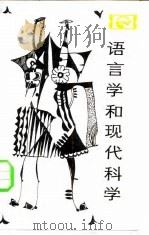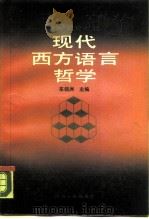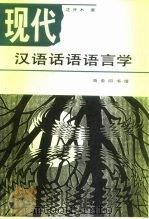《现代语言学 附现代语言学自学考试大纲》
| 作者 | 何兆熊,梅德明主编;全国高等教育自学考试指导委员会办公室组编 编者 |
|---|---|
| 出版 | 北京:外语教学与研究出版社 |
| 参考页数 | 368 |
| 出版时间 | 1999(求助前请核对) 目录预览 |
| ISBN号 | 7560015239 — 求助条款 |
| PDF编号 | 810260008(仅供预览,未存储实际文件) |
| 求助格式 | 扫描PDF(若分多册发行,每次仅能受理1册) |

Chapter1 Introduction1
1.What is linguistics?1
1.1 Definition1
1.2 The scope of linguistics2
1.3 Some important distinctions in linguistics4
1.3.1 Prescriptive vs.descriptive4
1.3.2 Synchronic vs.diachronic5
1.3.3 Speech and writing5
1.3.4 Langue and parole6
1.3.5 Competence and performance7
2.What is language?8
2.1 Definitions of language8
2.2. Design features11
Study questions14
Chapter2 Phonology15
1.The phonic medium of language15
2.Phonetics16
2.1 What is phonetics?16
2.2 Organs of speech17
2.3 Orthographic representation of speech sounds-broad and narrow transcriptions20
2.4 Classification of English speech sounds23
2.4.1 Classification of English consonants23
2.4.2 Classification of English vowels26
3.Phonology29
3.1 Phonology and phonetics29
3.2 Phone,phoneme,and allophone31
3.3 Phonemic contrast,complementary distribution,and minimal pair34
3.4.1 Sequential rules36
3.4 Some rules in phonology36
3.4.2 Assimilation rules38
3.4.3 Deltion rule39
3.5 Suprasegmental features-stress,tone,intonation40
3.5.1 Stress40
3.5.2 Tone43
3.5.3 Intonation43
Study questions46
Chapter3 Morphology48
1.Definition48
2.Morpheme49
2.1 Morpheme:the smallest meaningful unit of language49
2.2 Types of morphemes50
2.2.1 Free morphemes50
2.2.2 Bound morphemes51
2.2.3 Morphological rules54
3.Compounding55
3.1 Types of compound words55
3.2 Features of compounds56
Study questions57
Chapter4 Syntax59
1.Syntax as a system of rules59
2.Sentence structure61
2.1 The basic components of a sentence61
2.2 Types of sentences62
2.2.1 The simple sentence62
2.2.2 The coordinate sentence63
2.2.3 The complex sentence64
2.3.1 The linear word order of a sentence65
2.3 The linear and hierarchical structures of sentences65
2.3.2 The hierarchical structure of a sentence66
2.3.3 Tree diagrams of sentence structure67
3.Syntactic categories71
3.1 Lexical categories72
3.2 Phrasal categories73
4.Grammatical relations73
5.Combinatonal rules75
5.1 Phrase structure rules76
5.2 The recursiveness of phrase structure rules78
5.3 X-bar theory79
6.Syntactic movement and moement rules81
6.1 NP-movement and WH-movement82
6.3 D-structure and S-structure83
6.2 Other types of movement83
6.4 Move a-a general movement rule85
7.Toward a theory of universal grammar85
7.1 General principles of Universal Grammar86
7.2 The parameters of Universal Grammar87
Study questions88
Chapter5 Semantics91
1.What is semantics?91
2.Some views concerning the study of meaning91
2.1 The naming theory92
2.2 The conceptualist view92
2.3 Contextualism93
2.4 Behaviorism95
3.Lexical meaning95
3.1 Sense and reference96
3.2 Major sense relations97
3.2.1 Synonymy97
3.2.2 Polysemy100
3.2.3 Homonymy101
3.2.4 Hyponymy102
3.2.5 Antonymy102
4.Sense relations between sentences103
5.Analysis of meaning106
5.1 Componential analysis-a way to analyze lexical meaning106
5.2 Predication analysis-a way to analyze sentence meaning107
study questions110
1.2 Pragmatics vs.semantics112
1.1 Definition112
1.What is pragmatics?112
Chapter6 Pragmatics112
1.3 Context113
1.4 Sentence meaning vs.utterance meaning114
2.Speech act theory115
3.Principle of conversation121
Study questions123
Chapter7 Historical Linguistics125
1.The purpose and significance of the historical study of language125
2.The nature of language change126
3.The historical development of English127
3.1 Major periods in the history of English127
3.1.1 Old English129
3.1.2 Middle English129
3.1.3 Modern English130
3.2 Linguistic change of English131
3.2.1 Sound change131
3.2.2 Morphological change134
3.2.3 Syntactic change137
3.2.4 Lexical change141
3.2.5 Semantic change145
4.Language family148
4.1 Classifying genetically related languages149
4.2 The Indo-European language family151
5.The causes of language change153
5.1 Sound assimilation155
5.3 Internal borrowing156
5.2 Rule simplification and regulariztin156
5.4 Elaboration157
5.5 Sociological triggers158
5.6 Cultural transmission159
5.7 Children s approximation toward the adult grammar160
Study questions160
Chapter8 Sociolinguistics164
1.Language variation164
1.1 Speech community164
1.2 Speech variety165
1.3 Regional variation166
1.4 Social variation167
1.5 stylistic variation168
1.6 Idiolectal variation169
2.1 Standard and nonstandard language170
2.Standard and nonstandard language170
2.2 Lingua francas172
2.3 Pidgins174
2.4 Creoles176
3.Diglossia and bilingualism177
3.1 Diglossia177
3.2 Bilingualism179
4.Ethnic dialect181
4.1 Black English,a case study of ethnic dialect181
4.2 The social environment of Black English184
5.Social dialect185
5.1 Education varieties186
5.2 Age varieties186
5.3 Gender varieties187
5.4 Register varieties193
5.5 Address terms197
5.6 Slang199
5.7 Linguistic taboo201
5.8 Euphemism203
Study questions206
Chapter9 Psycholinguistics210
1.The biological foundations of language210
1.1 The case of Phineas Gage210
1.2 The human brain212
1.3 Brain lateralization213
2.Linguistic lateralization214
2.1 Left hemispheric dominance for language214
2.2 Dichotic Listening ressearch215
3.The language centers216
3.1 Broca s area217
3.2 Wernicke s area218
3.3 The angular gyrus219
3.4 Language perception,comprehension and production219
4.The critical period for language acquisition220
4.1 The critical period hypothesis220
4.2 The case of Genie and the degeneration of language facuity with age222
5.Language and thought225
5.1 Early views on language and thought225
5.2 The Sapir-Whorf hypothesis226
5.3 Arguments against the Sapir-Whorf hypothesis228
5.3.1 Words and meaning229
5.3.2 Grammatical structure230
5.3.3 Translation231
5.3.5 Languange and world views232
5.3.4 Second language acquisition232
5.4 Understanding the relation of language and thought233
5.4.1 Major functions of language233
5.4.2 The development and blending of language and thought233
5.4.3 Thinking without language234
5.4.4 Language as a conventional coding system to express thought235
5.4.5 The ways in which language affects thorght236
Study questions237
Chapter10 Language Acquisition240
1.First language acquisition240
1.1 The biological basis of language acquisition240
1.2 Language acquisition as the acquisition of grammatical rules242
1.3 The role of input and interaction243
1.4 The role of instruction245
1.5 The role of correction and reinforcement246
1.6 The role of imitation247
2.Stages of first language acquisition248
2.1 The prelinguistic stage250
2.2 The one-word stage251
2.3 The two-word stage252
2.4 The multiword stage255
3.The development of the grammatical system257
3.1 The development of phonology258
3.2 The development of syntax259
3.3 The development of morphology262
3.4 The development of vocabulary and semantics263
4.Second language acquisition264
4.1 Acquisition vs.learning265
4.2 Transfer and interference266
4.3 Error Analysis and the natural route of SLA developnent268
4.4 Interlanguage and fossitization269
4.5 The role of input270
4.6 The role of formal instruction271
4.7 Individual learner factors272
4.7.1 The optimum age for second language acquisiticn273
4.7.2 Motivation273
4.7.3 Acculturation274
4.7.4 Personality275
Study questions276
Suggested Answers to Study Questions278
An English-Chinese Glossary304
后记312
现代语言学自学考试大纲313
1999《现代语言学 附现代语言学自学考试大纲》由于是年代较久的资料都绝版了,几乎不可能购买到实物。如果大家为了学习确实需要,可向博主求助其电子版PDF文件(由何兆熊,梅德明主编;全国高等教育自学考试指导委员会办公室组编 1999 北京:外语教学与研究出版社 出版的版本) 。对合法合规的求助,我会当即受理并将下载地址发送给你。
高度相关资料
-

- 语言学和现代科学
- 1984 成都:四川人民出版社
-

- 现代语言学
- 1983
-

- 现代汉语 自学考试题解
- 1998.03 中华工商联合出版社
-

- 中国现代语言学家
- 1981 石家庄:河北人民出版社
-

- 现代语言学理论
- 1998 昆明:云南人民出版社
-

- 现代公关语言学
- 1995 呼和浩特:内蒙古人民出版社
-

- 中国现代语言学史
- 1995 广州:广东教育出版社
-

- 现代语言学
- 1983 北京:知识出版社
-

- 现代语言学导论
- 1986 福州:福建人民出版社
-

- 语言学与现代科学
- 1983 成都:四川人民出版社
-

- 西方现代语言哲学
- 1989 天津:南开大学出版社
-

- 现代西方语言哲学
- 1989 成都:四川人民出版社
-

- 现代汉语话语语言学
- 1996 北京:商务印书馆
-

- 现代语言学入门
- 1990 北京:北京语言学院出版社
提示:百度云已更名为百度网盘(百度盘),天翼云盘、微盘下载地址……暂未提供。➥ PDF文字可复制化或转WORD
